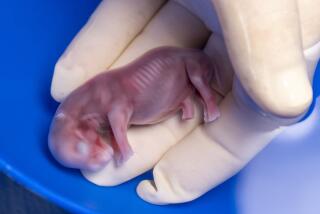New species of ancient rhinoceros found in Tibet
- Share via
Searching across the Tibetan plateau, paleontologists have discovered a species of woolly rhinoceros that may be an ancestor of the great ice age beasts that roamed the plains of North America, Europe and Asia.
The Coelodonta thibetana fossil dates to about 3.7 million years ago, about a million years before other known woolly rhinos. The findings, published in Friday’s edition of the journal Science, lead researchers to believe that before the ice age began, the chilly Tibetan highlands may have served as an evolutionary cradle for cold-hardy mammals whose descendants thrived in the glacial times that followed.
Paleontologists have yet to fully trace the origins of many of the giant, hairy beasts that lived during the most recent ice age, which lasted from about 2.6 million to 10,000 years ago. Many of these animals, whose massive bodies conserved heat effectively, were thought to have evolved in Eurasia from animals that managed to survive and adapt to an increasingly cold environment.
The new fossil from the Zanda Basin in Tibet may provide an alternative evolutionary explanation for some of those animals, said study coauthor Xiaoming Wang, a vertebrate paleontologist with the Natural History Museum of Los Angeles County.
Wang’s international team did not go to the Tibetan highlands expecting such a find. Tibet’s elevated plains are relatively untouched paleontologically, and the scientists were simply looking to learn about the history of the area’s animal life from whatever fossil evidence they could dig up. Team members would often walk five to 10 miles in a day, scanning the earth for signs of fossil fragments.
It was Wang who discovered a neck-bone fragment poking out of the ground one August afternoon in 2007. He had barely begun digging when his hammer hit the skull. He brushed away dirt, baring giant teeth.
Short on supplies and with just a few days left on the expedition, Wang and colleagues were faced with a dilemma. They could wait for their next trip to take the fossil home — but leaving it partially exposed would make it vulnerable to the elements.
Instead, the team decided to dig out the fossil as fast as they could. The scientists sped to the nearest hospital, about 60 miles away, and begged a doctor for plaster to protect the fragile specimen. Without the plaster to encase the bones, Wang said, the fossil “would have fallen apart into a thousand pieces before we got back into Beijing.”
“The doctor was really gracious,” Wang added. “We managed to convince him that this is a special case, that he will be able to make a big contribution to science.”
Several months after a harrowingly bumpy ride back to Lhasa and then Beijing, the researchers realized the significance of their discovery: It was a new species of rhinoceros that had developed cold-hardy attributes at least a million years before the ice age got underway. The rhino, about 10% lighter than its ice age descendant, had a hairy body and a flattened horn useful for sweeping away snow to get at vegetation.
The team also found other creatures — blue sheep, snow leopards and Tibetan antelope — that had acquired similarly snow-ready qualities. Perhaps this part of Tibet had been a specialized breeding ground for cold-tolerant animals that were able to thrive and spread once the big freeze hit. It will take more digging to find out.
“This is just the first shot across the bow in terms of possible evidence of preadaptations to cold climates,” said Donald Prothero, a mammalian paleontologist at Occidental College. “It’s possible that quite a few more of these major ice age groups will turn out to be from Tibet. We’ll see when they get more specimens.”







